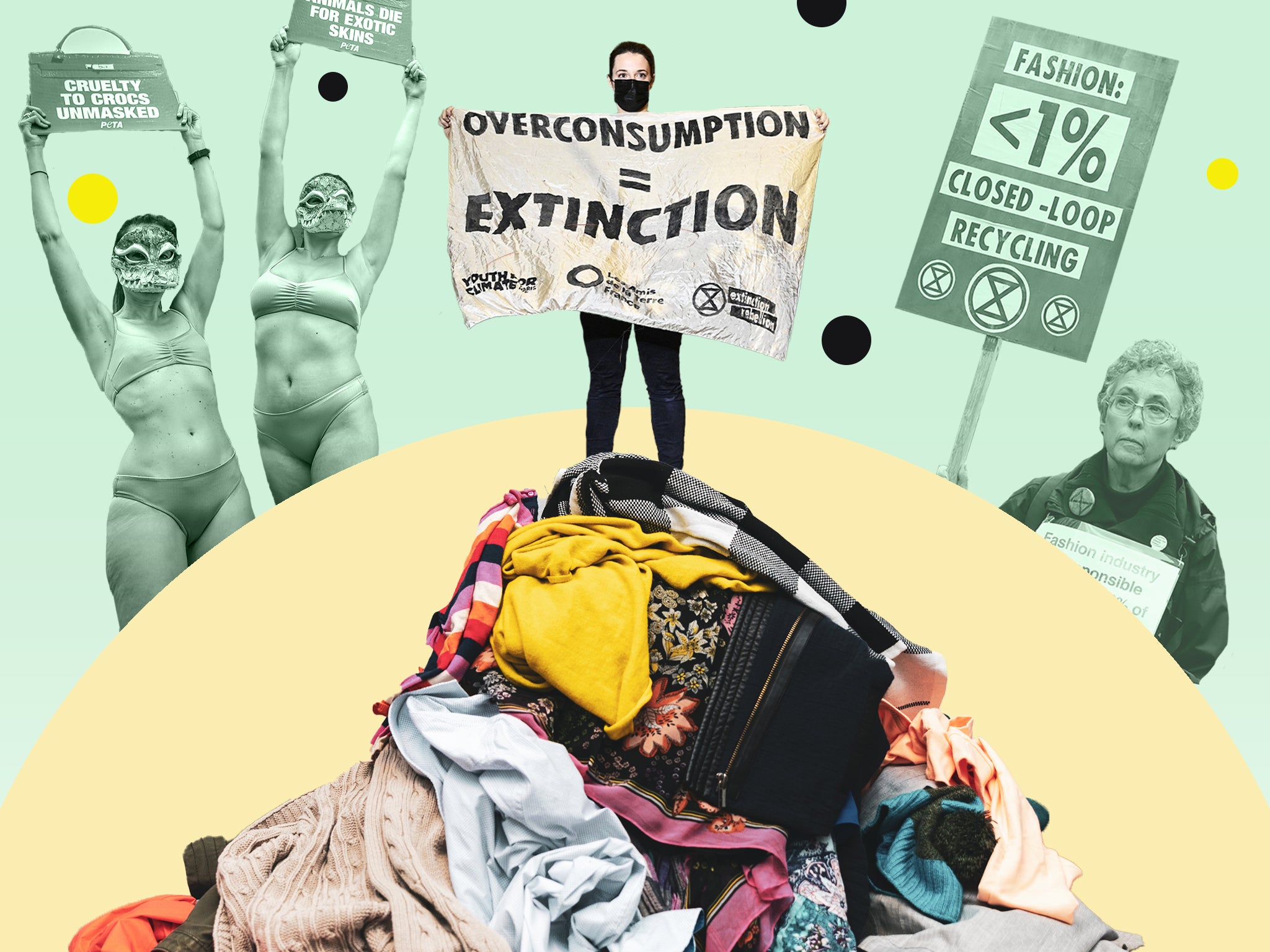The Independent's journalism is supported by our readers. When you purchase through links on our site, we may earn commission.
Was 2021 the year we moved away from fast fashion?
As the year comes to a close, Olivia Petter reflects on progressions – and shortcomings – within the sustainable fashion sector


It’s been quite a year for the fashion industry. With an awards season comeback – and a gradual return to a life without coronavirus restrictions – the sartorial stakes were high. And not just because people wanted to make up for the many months they spent swaddled in loungewear.
Because while the world was on pause, the climate crisis raged on. With fatal floods, wildfires, a deep freeze, and the United Nations’ “Code Red” report, it’s been impossible to ignore the ecological damage that has been done this year. And of course, like all industries, fashion has an important role to play when it comes to finding solutions.
Thank goodness, then, that progress appears to have been made. In 2021, the rental fashion market continued to boom. This was partly thanks to an uptick in media coverage and the number of celebrities, like Holly Willoughby, and Laura Whitmore, who proudly wore their rented items at high-profile events. According to GlobalData, the rental industry is going to be worth £2.3bn by 2029.
Elsewhere, the red carpet was transformed. What was once a place reserved for standout ensembles never to be worn again became a stage for re-wearing the same clothes – or creating new pieces out of old ones. Everyone was doing it, from Lorde (whose Met Gala outfit was made using deadstock fabrics) to the Duchess of Cambridge, who re-wore a Jenny Packham gown that she first wore in 2019 to the Royal Variety performance at the Royal Albert Hall in November.
Such things may seem minor in the grand scheme of things, but they send a message to the masses. One that promotes more sustainable modes of consumption. Luxury brands are embracing new, eco-friendly manufacturing processes to reduce their carbon footprint, too. Take Hermès, which created the first bag using Sylvania mushroom leather, while Alexander McQueen launched a partnership with second-hand e-tailers Vestiaire Collective that calls on trusted clients to sell their unworn pieces.
Meanwhile, many independent British brands, such as Phoebe English, have drastically reduced their output so that they produce just one collection a year. As for fashion’s rising stars of 2021, well, they’ve all been eco-conscious designers, like Harris Reed, whose debut London Fashion Week show in September showcased gender-fluid bridal and groomswear made from fabrics that had all been sourced from Oxfam.
“The broader industry has shifted to become more sustainable this year,” says Emily Gordon-Smith, director of Consumer Product at trend forecasting company Stylus. “In particular, we’re seeing good work going on in the use of more sustainable fabrics and we’re also seeing that being marketed well in clear messaging.”
The pandemic might have also helped to trigger a shift in terms of how we consume clothing. “I think there’s been a cultural awakening of sorts, in that difficult questions about the industry and its practices are circulating more widely,” suggests Bel Jacobs of Fashion Act Now, the climate crisis campaign group that evolved out of Extinction Rebellion.
“This is as a result of multiple emergencies, from the pandemic to Black Lives Matter and to the climate and ecological emergency itself, and seeing how fashion intersects profoundly with each. We are starting to understand that fashion is essentially extractivist, exploitative, racist, and even sexist in the ways it works. So lots of good people are currently trying to do their best to turn this ship.”
That said, now is not a time to be complacent. Society might have woken up to the urgency of the climate crisis – and the subsequent need to redress their consumption habits – but that doesn’t mean every sustainable fashion initiative you see is always a force for good.
“We have definitely not moved away from fast fashion in 2021,” says Dana Thomas, author of Fashionopolis: The Price of Fast Fashion and the Future of Clothes. “Zara and H&M were back up to their pre-pandemic sales levels by the autumn, and are forecasted to keep increasing.”
Today, the environmental consequences of fast fashion are well-documented. During Fashion Revolution’s revolution week this year, it emerged that 200 million trees are felled annually to produce cellulosic fabrics, with 35-40 per cent of those coming from old-growth woodlands. Meanwhile, according to the UN Environment Programme, two per cent of global wastewater comes from textile dyeing. It has also been estimated that around half a million tonnes of plastic microfibres shed during the washing of synthetic textiles such as polyester, nylon, or acrylic end up in the ocean annually. On top of this, an estimated £140m worth of clothing is sent to UK landfill each year. Pair all this with the mass production rates and methods employed by fast fashion brands and it’s a recipe for disaster.
The figures are far from encouraging. Maria Chenoweth, CEO at Textile Reuse and International Development (TRAID), says that people might be armed with more knowledge when it comes to the consequences of fast fashion, such as deforestation and increased carbon emissions, but these concerns have yet to have an impact on our shopping habits.
“The apparel market is growing and expected to reach £67 billion in the UK by 2026,” says Chenoweth. “The concept of sustainability has gained huge currency in fashion but evidently, it’s making little impact on reversing the growth of fast fashion. We need to stop blaming individual consumers and instead focus on the retailers and brands responsible for the relentless over-production of cheap disposable clothes.”
Meanwhile, misleading business strategies such as greenwashing – when brands promote environmentalism without actually employing the sustainable business practices their marketing materials would suggest – appears to have surged this year given the number of brands who are keen to capitalise on the demand for eco-friendly fashion without actually making any tangible change to production of manufacturing processes.
“Conscious collections, boasting about having factories put solar panels on their rooftops... this is not going to effect the sort of changes that are needed meet climate goals that companies themselves have set, or the Paris Climate Agreement goals,” adds Thomas. “As long as handbags are coated with PVC, and clothes are sourced from the other side of the planet, where people are paid half a living wage – because poverty and climate change go hand-in-hand– and brands are still overproducing and pushing overconsumption, fashion is as big a polluter, if not more, as it was before the pandemic.”
The problem is such that some campaigners are unsure as to whether fashion, an industry that is fundamentally predicated on consumption, can ever be environmentally friendly. Even the rental sector, originally thought to be greener given its circularity, has been questioned. In July, a study published by the Finnish scientific journal Environmental Research Letters suggested that renting clothes might be even worse for the planet than throwing them away due to a number of hidden environmental costs, such as delivery, packaging, and dry cleaning.
“I would question our continued use of the word sustainable in relation to fashion,” says Shonagh Marshall of Fashion Act Now. “If you look at consumption, it is up and some of the biggest fashion companies, such as Kering, have reported larger profits in the first half of 2021 than pre-pandemic. There have been some interesting material innovations but it is yet to be scaled to a level to make a significant difference.”
Evidently many brands need to take stock and really overhaul their businesses if we’re ever to see any real progress when it comes to moving away from fast fashion. “They need to stop prizing profit over people and planet,” says Chenoweth. “And stop selling a dream that constantly updating our wardrobe makes us better, more desirable human beings when fashion’s reality is exploitation labour and environmental catastrophe.”
We can, of course, do more on an individual level, too. “Consumers should understand the power they have to make a positive impact,” says Francesca Muston, vice president of fashion at trend forecasting company WGSN. Asking the right questions of brands you like, she says, is key. “If something is flagged as sustainable, green or eco ask why and how? Search for sustainable options – you’ll leave a data trail retailers will analyse and respond to,” she suggests.
How you choose to care for your clothes is vital, too. By prioritising the items you already own, washing them sparingly, and avoiding tumble drying them, you can extend their lifespan and therefore avoid the need to purchase more items to replace them. However, as Muston points out, the best thing you can do is actually very simple, and it doesn’t require you to buy a thing. “Ultimately, it doesn’t matter what the label says; if you don’t wear something then it’s not sustainable,” she points out. “So, arguably, one of the most important things you can do is to wear your clothes and love them.”
Join our commenting forum
Join thought-provoking conversations, follow other Independent readers and see their replies
Comments
Bookmark popover
Removed from bookmarks